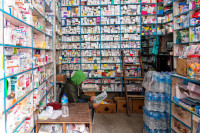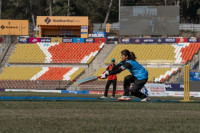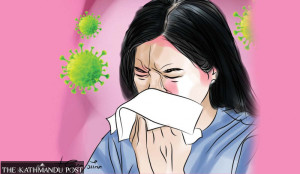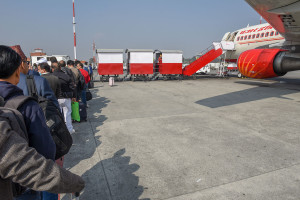Health
Health authorities mull mass vaccination against cholera
At least 50 people have contracted cholera across country so far this year. Contamination of all water sources poses a challenge in containing spread of deadly disease, officials say.
Arjun Poudel
As the spread of cholera continues unabated, agencies under the Ministry of Health and Population have started discussions to explore the possibility of vaccinating the people in affected areas against the deadly disease.
Officials said that health authorities concerned and aid agencies held several rounds of discussions about containing the ongoing spread of the highly contagious disease.
“We have also held discussion with the officials of the World Health Organisation in Nepal about the possibility of inoculating the people in the cholera hit areas including Lalitpur,” said Dr Yadu Chandra Ghimire, director at the Epidemiology and Disease Control Division. “We have also planned to discuss the issue with experts from the National Immunisation Advisory Committee.”
Cholera is a highly infectious disease that causes severe diarrhoea and vomiting, leading to dehydration and even death within a few hours if untreated. The World Health Organisation says cholera is a global threat to public health and an indicator of inequality and a lack of social development.
At least 50 people from four districts—38 in Lalitpur, eight in Kailali, and two each in Kathmandu and Pyuthan districts—have contracted cholera so far this year. Health officials said that the Vibrio cholera 01 Ogawa serotype has been confirmed in the stool samples of the infected patients.
Public health experts said that detected cases of cholera infection could be just a tip of the iceberg, as most of the positive cases are being reported from the districts having active surveillance, including the three districts of the Kathmandu Valley and Kailali.
Last year, health authorities administered an oral cholera vaccine in Kathmandu Metropolitan City’s wards 11, 12, and 13, which were highly affected by the outbreak. Vaccines against the deadly disease were administered in Kapilvastu and Rautahat districts in the past after all efforts to contain the spread of the disease failed.
Health officials concede that even if they have discussed the issue of inoculating people from the disease hit areas with anti cholera vaccine, it is easier said than done. They said that finding an anti-cholera vaccine is challenging, as production of the vaccine itself is very low. Moreover, the government has not allocated a budget for the programme.
“We have also talked with representatives of the Global Alliance for Vaccine and Immunisation (GAVI), which provides vaccines free of cost to Nepal,” Ghimire said. “But they told us that the chance of supplying vaccines in the near future is low. We have to prepare for cholera vaccination for next year.”
Cholera outbreaks during the monsoon season are not a new thing in Nepal, as hundreds of people throughout the country suffer from diarrhoeal infections that continue for months every year and scores contract the disease.
In 2022, a total of 77 cholera cases were confirmed in the Valley.
Public health experts say that due to poor sanitation and hygiene conditions, the country as a whole is highly vulnerable to water-borne illnesses including diarrhoea, dysentery, typhoid, hepatitis, and cholera, with thousands of people getting infected every year.
They say sheer negligence from authorities concerned is responsible for ongoing outbreak of diarrhoeal diseases including the deadly cholera.
Health authorities in most local units had stopped the testing of drinking water just before the start of the monsoon season, citing lack of funds, although deadly microbes such as faecal coliform and E coli were frequently detected in drinking water samples.
Most of the water sources contaminated with deadly microbes
Officials at the Health Office, Lalitpur said that contamination of most of the sources of water—tap water, ground water, tanker water—is a main challenge to contain the spread of the cholera.
“We have yet to check the quality of the jar water, which is widely used in offices, hotels and homes for drinking,” said Dr Bhuwan Paudel, chief of Health Office, Lalitpur. “But faecal coliform has been found in most of the samples of tap water, ground water and tanker water being used in Lalitpur.”
Faecal coliform, a microscopic organism, is found in human faeces. According to doctors, the presence of faecal coliform in drinking water means it is contaminated with sewage.
Doctors say bottled water, which is widely used by households and offices in Kathmandu Valley, is generally considered safe, but water quality of several companies have been found questionable. Dangerous microbes are detected in bottled water every year, which means not all jar water brands are safe to drink without treatment.
They say consumption of contaminated water not only can cause diarrhoeal infections and deadly cholera but also increases the risk of contracting dysentery, typhoid, and hepatitis A and E.
They stress that awareness drives and ensuring safe drinking water are crucial to protect people from water-borne diseases.
A combination of careful surveys, provision of safe drinking water, good sanitation and hygiene standards, social mobilisation and treatment is required to contain the spread of infection, according to doctors.
Doctors have asked authorities to launch awareness drives against water-borne diseases and ensure safe drinking water to prevent deaths from illnesses like cholera.
To contain the spread of the infection, a combination of careful surveys, ensuring safe drinking water, maintaining sanitation and hygiene, social mobilisation, and treatment is required, according to experts.
The World Health Organisation has also said that a multifaceted approach is key to controlling cholera and reducing deaths.




 8.12°C Kathmandu
8.12°C Kathmandu















